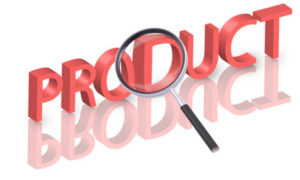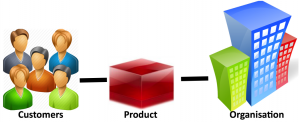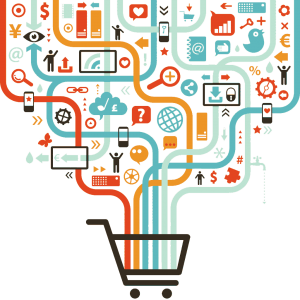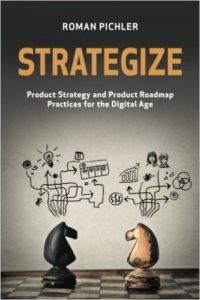Overview
Many companies are moving towards a product model with product managers, product visions, product strategies, product roadmaps, product backlogs, product increments and even minimum viable products but do we all agree on what a product actually is?
Without a clear understanding and agreement on terminology we can get impede alignment and stall change initiatives. Within this post I have attempted to clarify what a product is and how it differs from traditional projects.
Product Definition
Definition: A product is a tangible item produced to create specific value for a group of customers and to the organisation that provides it.
A product solves a problem (think DropBox which provides an easy way to store and share files) or provides a benefit (such as discovering new places and locating your friends in FourSquare) to the customer.
Additionally, the product creates value for the organisation by directly creating revenue (e.g. Microsoft Office), helping to develop other products (e.g. Visual Studio), providing marketing (e.g. Google AdWords) or selling another product (e.g. AppStore or iTunes).
And lastly:
- a product needs a name people can remember and relate to
- it has clear and communicable benefits for the customer
- it is adaptable with time, trends and changes in market segments in order to keep it relevant and maintain its revenue stream.
The difficulty is finding a worthwhile problem to solve and creating an innovative and valuable solution to address it. Lean Startup helps in creating and validating the product model prior to the general product life cycle stages of development, introduction, growth, maturity, saturation, extension and decline.
Definition: A project is a temporary and one-time endeavour undertaken to create a unique product or service, which brings about beneficial change or added value.
Projects have definite beginning and end points, and thus have a limited duration. Products continue to be developed and supported until they reach their end of life and are discontinued.
Project success is determined if the scope is met within the time and cost commitments. Products are considered successful if they meet the customer needs and business goals. Product-market fit typically takes longer to achieve prior to the profitable growth stage.
An example product is OS X, the operating system for Macintosh computers which was launched in 2001. Since its launch there have been twelve major releases of OS X including most recently El Capitan in June 2015 which could be viewed as a project that focused upon performance, stability and security.
Products versus Features, Components, Services and Capabilities
People often confuse products with features, capabilities, components and services:
- Product – a tangible item produced to create specific value for a group of customers and to the organisation that provides it. Example: AmazonFresh offering perishable and non-perishable groceries delivered directly to the customer’s home.
- Feature/Capability – a product characteristic that customers can interact with to perform a specified task. A feature or capability does not solve a problem on its own, it requires additional features to address customer needs. Features/capabilities are typically listed on a product website or box in order to promote its usefulness. Example: a search feature on Amazon.co.uk allows customers to locate books by title, author, ISBN, publisher, keywords, format, reader age, seller or publication date. You do not go to Amazon to search for books, you visit to buy a book.
- Component – an architectural building block developed for a product. Individual components do not create measurable value for the organisation but instead are constituent parts of the product. Example: a compound interest calculator within a financial application or the checkout component within Amazon.co.uk.
- Channel – the method used to interact with customers. A channel may be a website, promotional event, a product package or in-person consultancy.
- Service – “any act or performance offered that is essentially intangible and does not result in the ownership of any thing”- Egellond. The wider ability to fulfil a customers need, either in its own right or as a significant element of a product. Services can be abstract and intangible and include physical evidence (“the environment in which the service is delivered, where the firm and customer interact, and any tangible components that facilitate performance or communication of the service”- Zeithaml), people (those involved in the customer experience and how the service is delivered) and process (how the service is carried out). Example: providing a pension via initial consultation, evaluation of options, review with customer, provision of agreed solution and providing ongoing support for the provided package.
Other Factors
Life is never black and white and there are many complications within the area of product engineering.
Features and components can be unbundled from an offering to create new products. For example, the checking-in and real-time location sharing aspects of FourSquare were separated into a new application named Swarm. This creates new opportunities and enables market segmentation.
Often multiple products are offered together in a Product bundle, for example the Amazon website includes many products such as Amazon Drive, Kindle Unlimited, Prime and LOVEFiLM.
An alternative view of a product is an item, service or idea consisting of a bundle of tangible and intangible attributes that satisfies consumers and is received in exchange for money or some other unit of value. In this view a product can include a service as described above, it is usually simpler to keep the definition of product as the tangible item and service as intangible.
Products are developed and supported long-term within an organisation to address a customer need and provide benefit to the business.
Restructuring companies to follow a product model can remove inefficient short-term optimisations and avoid the issues associated with people task switching. This enables value to be maximised by addressing customer’s needs and solving market problems.
For further information, see the excellent book Strategize: Product Strategy and Product Roadmap Practices for the Digital Age by Roman Pichler.
#ScrumRonin



